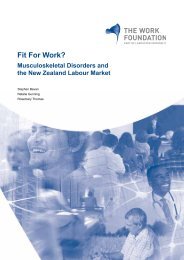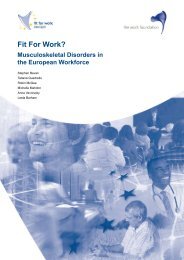FfW Bulgarian report (English language) - Fit for Work Europe
FfW Bulgarian report (English language) - Fit for Work Europe
FfW Bulgarian report (English language) - Fit for Work Europe
Create successful ePaper yourself
Turn your PDF publications into a flip-book with our unique Google optimized e-Paper software.
injuries or back pain 15 ; Sieper, Braun, Rudwaleit, Boonen and Zink (2002) suggest an average<br />
of seven years between disease onset and diagnosis. Typical AS symptoms include pain<br />
(particularly in the early morning); weight loss, particularly in the early stages; fatigue; fever and<br />
night sweats and improvement after exercise. Again, as with RA, the temporal aspects of the<br />
disease require good management to ensure that individuals can per<strong>for</strong>m their job but do not<br />
make work impossible.<br />
Approximately half of individuals with AS are severely affected whilst others <strong>report</strong> very few<br />
symptoms. AS is generally considered to be a disease in which many individuals can maintain<br />
relatively good functional capacity (Chorus, Boonen, Miedema and van der Linden, 2002), yet<br />
<strong>report</strong>ed unemployment rates are three times higher among people with AS than in the general<br />
population (Boonen, Chorus, Miedema, van der Heijde, Landewé et al., 2001).<br />
Recent research has provided evidence that physical health-related quality of life of people with<br />
RA (Chorus, Miedema, Boonen and van der Linden, 2003) and AS (Gordeev, Maksymowych,<br />
Evers, Ament, Schachna et al., 2010) was positively influenced by work. Chorus et al.’s<br />
conclusion was that work ’might be an important factor in positively influencing patients’<br />
perception of their physical per<strong>for</strong>mance‘. This finding concurs with Waddell and Burton (2006a)<br />
that, overall, good quality work has health and recuperative benefits <strong>for</strong> workers. The extent<br />
to which the workplace can have a positive or negative effect on development of MSDs is<br />
discussed below.<br />
Psoriatic arthritis (PsA) is a <strong>for</strong>m of joint inflammation affecting between 0.2 and 1 per cent<br />
of the general population (Wallenius, Skomsvoll, Koldingsnes, Rødevand, Mikkelsen et al.,<br />
2008) and between 10 and 20 per cent of individuals with psoriasis. Prevalence figures <strong>for</strong> this<br />
condition were not found <strong>for</strong> Bulgaria. When joints are inflamed they become tender, swollen<br />
and painful on movement. The joints are typically stiff after resting, early in the morning or<br />
while resting in the evening. Tissues such as ligaments, tendons around the joints may also<br />
be involved. Inflammation of tendons or muscles (such as tennis elbow and pain around the<br />
heel) are also features in those with psoriatic arthropathy. In approximately 80 per cent of cases<br />
the arthritis develops after the appearance of psoriasis. Men and women are considered to be<br />
equally affected, and comparative studies have showed that patients with PsA have a burden of<br />
illness which is comparable to that of patients with RA or AS (Wallenius et al., 2008).<br />
There are several features that distinguish PsA from other <strong>for</strong>ms of arthritis: one pattern of<br />
inflammation is usually in the end of finger joints. Another pattern is involvement of the joints<br />
15 Expert interview<br />
<strong>Work</strong> and MSDs in Bulgaria<br />
<strong>Fit</strong> For <strong>Work</strong>? 27







